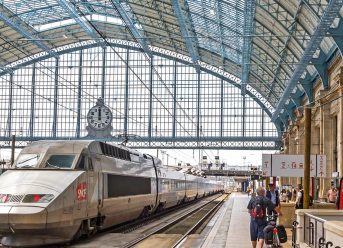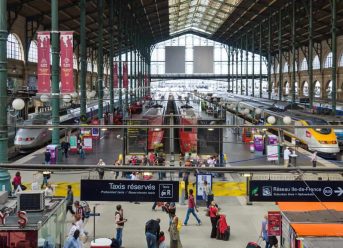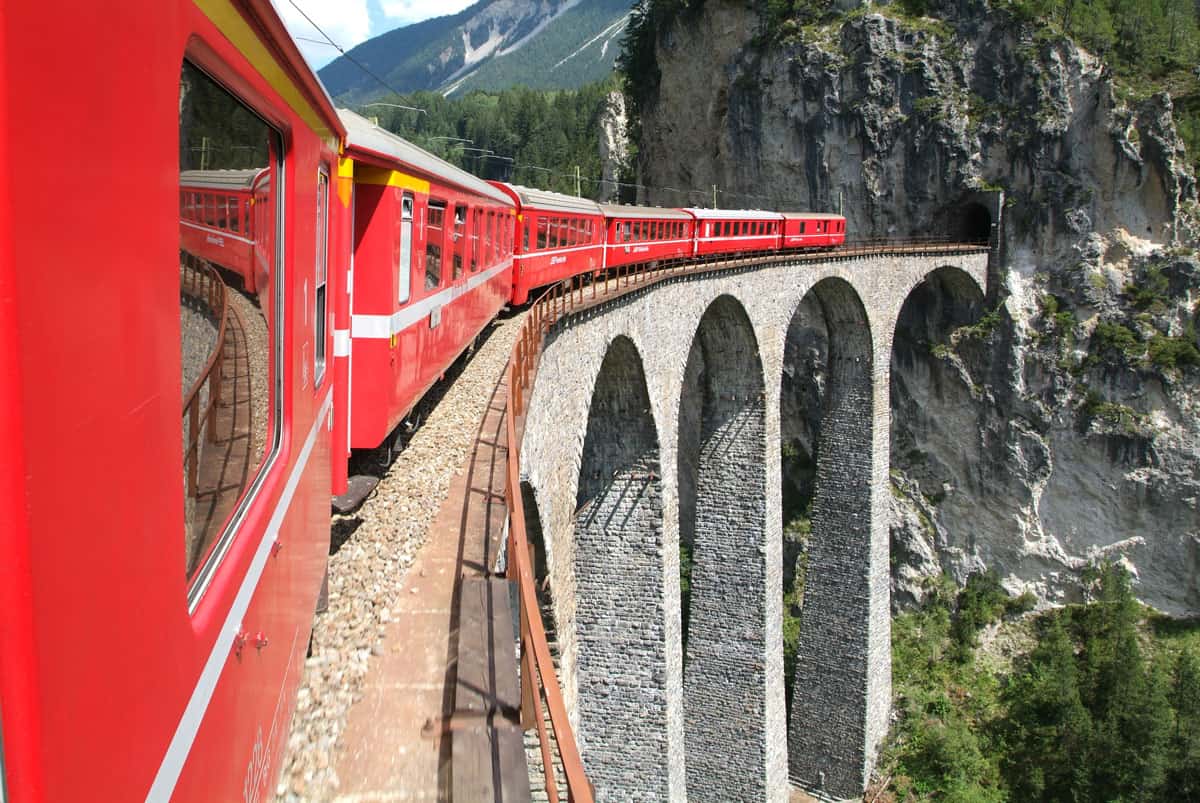
Swiss trains run like clockwork—in fact, Switzerland arguably has the most reliable train network in Europe. You can essentially get just about anywhere quickly and efficiently on the train and the views can’t be beaten (especially on the scenic routes). However, like everything in Switzerland, the trains are expensive but there are some ways to help keep costs down. So keep reading our Switzerland train guide to learn the ins and outs of Swiss train travel.
How To Buy Swiss Train Tickets
There are a few different ways to buy train tickets in Switzerland.
The easiest way to buy train tickets is through 3rd party booking sites like Omio and TrainLine. Both these companies are super user-friendly, their apps work well, and they’ve worked the technical bugs out of the booking process. These services will also display discounted Supersaver tickets.
You can also book through the Swiss Rail website but some people report weird translation issues and sometimes the website has problems processing international credit cards.
You can also book tickets at the train station but you’ll need to wait in line if you don’t pre-purchase your tickets online.
How To Book Standard Swiss Train Tickets
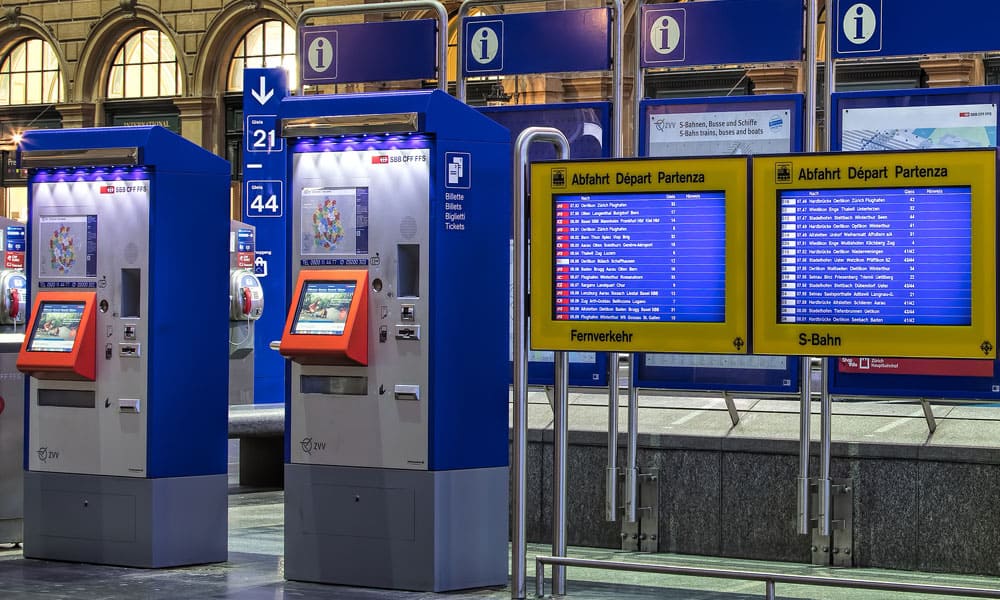
As mentioned above, you can book your tickets directly at the train station since there is very little discount for booking domestic tickets early. You can use the service window (the workers will almost always speak English) or the automated machines (also in English).
I prefer using 3rd party booking sites like Omio and TrainLine since you can skip the line and have the digital train tickets sent directly to your phone.
You can also purchase tickets (and check train times/prices) directly from the Swiss Federal Railways website (SBB) www.sbb.ch.
Important! Beware when looking at ticket prices on www.sbb.ch because they automatically assume you’re using a half-fare travel card (which most Swiss citizens have). You must click “no discount” in the “Discount Card” drop-down menu. See below:
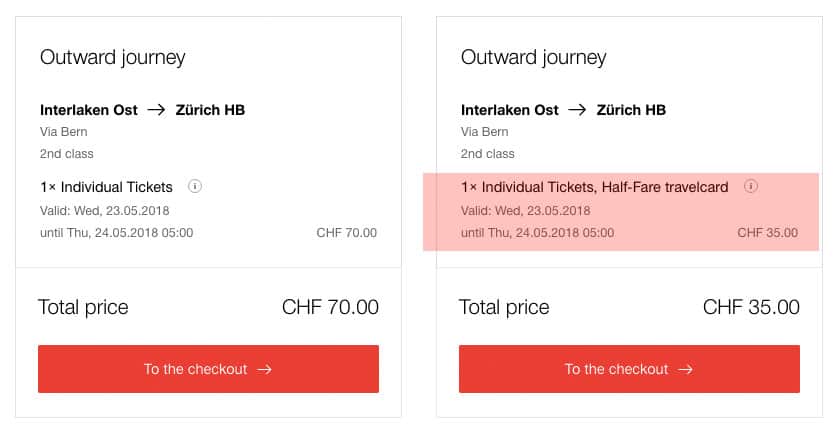
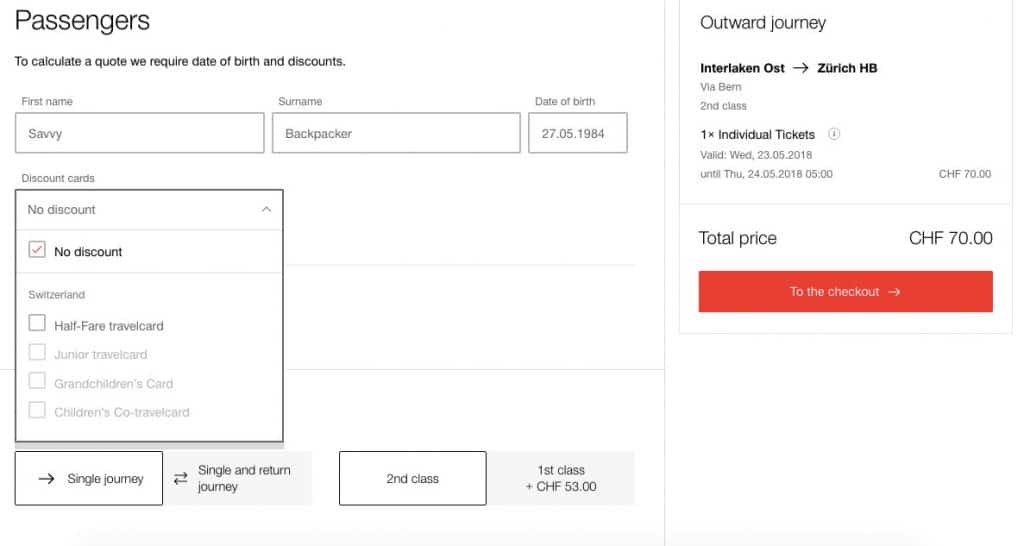
A few notes about Swiss train tickets:
- Your ticket is valid for any train for the route you purchased as long as you travel on the travel date printed on the ticket.
- For example, you can buy a ticket from Zurich to Lucern for an 8 am train but you can hop on the 11 am train if you want — just as long as it’s the same day.
- You can break up your train journey by getting off at any stop along the route and then hop on another train going that same route — as long as it’s the same day.
- For example, on a train going from Zurich to Lucern, you could exit the train at any stop along the way, spend a few hours there, and then get on another train late that day to complete the journey.
- Most international high-speed tickets will require a reservation — especially for trains between Switzerland and Germany (Eurocity trains) or France (TGV trains).
Supersaver Tickets
The Supersaver is a special online-only ticket that gives a bit of a discount on certain routes. To find these fares, simply do a standard search on www.sbb.ch and look for results with a “%” next to it.

Then when you go to book the ticket you’ll need to select the “Supersaver Ticket” option. In this example, it knocks off about CHF 10 (which is about $10).

Note: Unlike normal Swiss train tickets, the Supersaver ticket is ONLY good for the specific train on the ticket — it can’t be used on any other train/time. So you do lose your flexibility.
Half-Fare Travelcard
Earlier we mentioned the Half-Fare Travelcard which gives 50% off all train tickets within Switzerland. The card costs CHF 120.00 ($130) for a month. This can save you some money if you take a lot of train rides in Switzerland but you’ll need to do the math first.
In general, you’ll need to take anywhere from 3-5 rides in a month for the half-fare card to be a good deal — but it depends on the length of the rides (i.e. the longer the more expensive).
Note: the card is also good for bus, boat, and tram travel.
Rail Passes
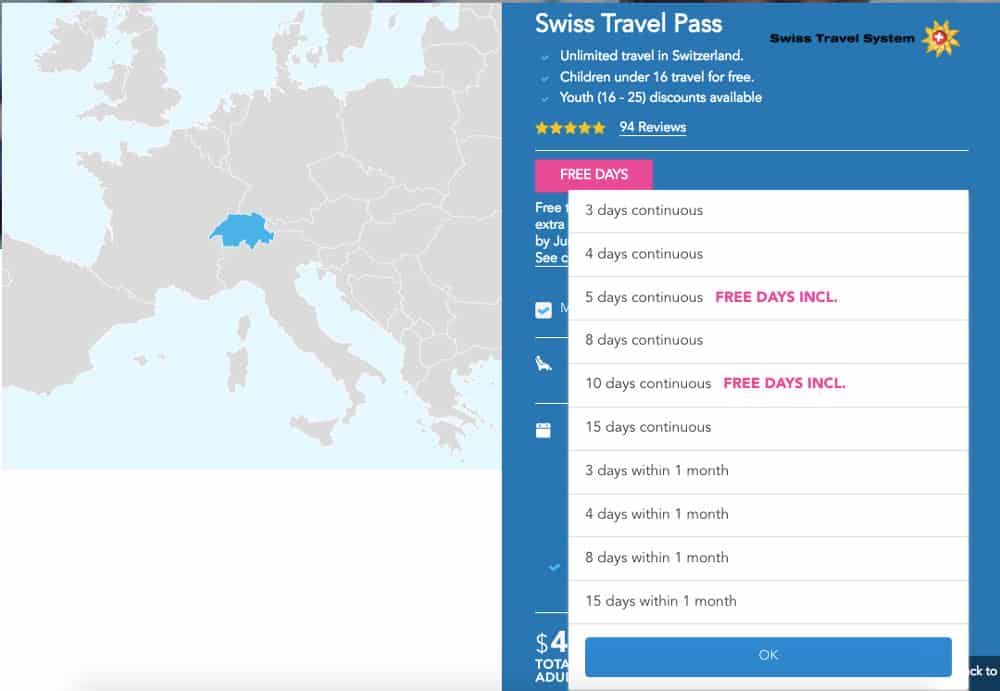
Eurail Passes for Switzerland can actually be a pretty good deal since normal tickets are expensive and there are no extra reservation fees for rail pass users. There are a number of Eurail Passes available but here are the main pass options:
- 3 to 15 Travel Days In a Month: In this option, you can choose 3, 4, 8, or 15 travel days in a month. This is a nice option because you have a bit of flexibility to stay in each location for a few days if you want. Learn more about Eurail passes at Eurail.com.
- 3 to 15 Consecutive Travel Days: In this option, you can choose 3, 4, 5, 8, 10, or 15 consecutive travel days. This is a good option if you’re wanting to see a lot of different places in Switzerland.
- Learn more about Eurail passes at Eurail.com.
- Regional and Global Passes: If you’re visiting more than Switzerland then you can look into Regional or Global Passes. Learn more about Eurail passes at Eurail.com.
Determining the rail pass value is fairly straightforward. First, calculate the per-day value of the pass. For example, a second-class four days within a month Swiss pass is $327 — which is $82 per travel day. Therefore, if you were to buy normal point-to-point tickets they would need to cost more than $82/each for the pass to be worthwhile. So head to www.sbb.ch to plug in your desired journeys and see the prices.
Scenic Train Routes in Switzerland
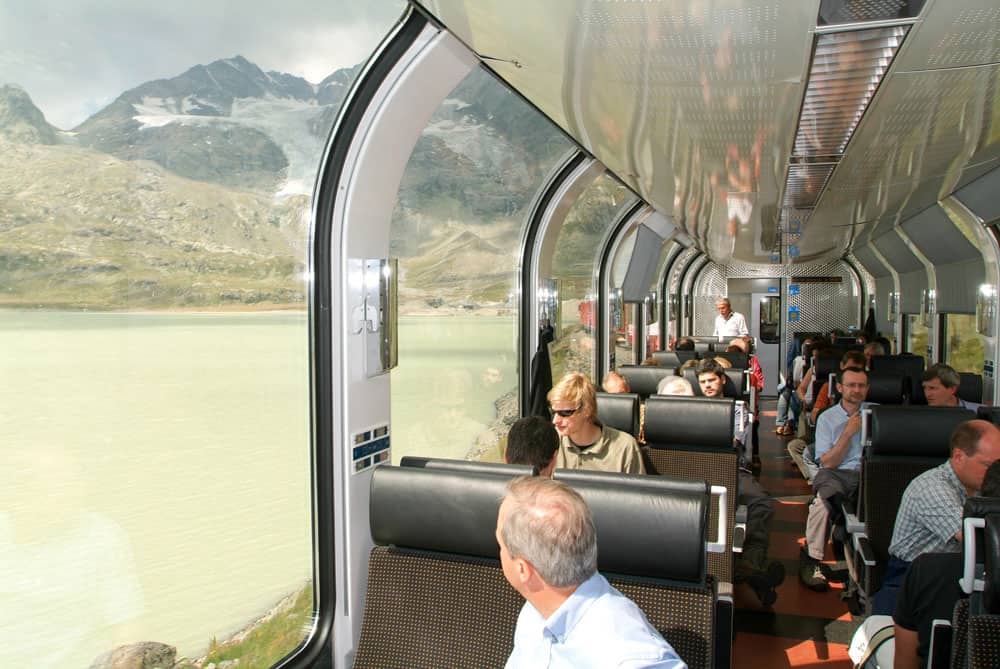
Switzerland offers some of the most beautiful views in Europe and there are a few special “scenic routes” that are often run by private railways. These tickets can be a bit expensive but it’s an unforgettable experience. Note: These trains often have an extra reservation fee for rail pass users.
The most famous scenic routes are:
- Bernina Express
- Chocolate train
- Centovalli Railway
- Golden Pass
- Glacier Express
Tips For Using Swiss Trains
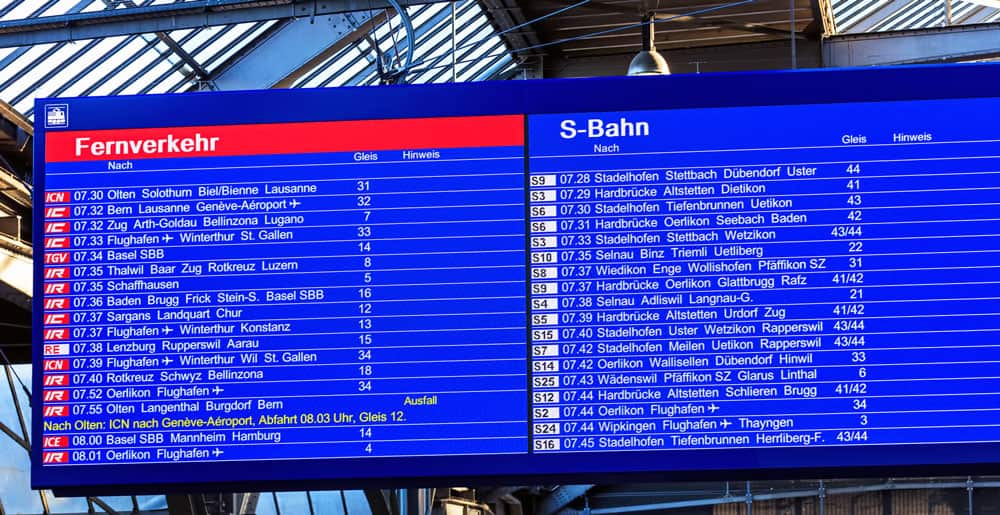
First, we recommend getting to the train station about 20 minutes early so you can find your train platform in plenty of time — by the way, there is no check-in… you simply get on the train. Most stations are easy to navigate but it’s best to play it safe. Also, if you’re buying a ticket at the station you should leave more time because there can be lines to use the machines.
To find your train be sure to look at the departures board. This will tell you where to find your train. Pay attention to the board as the platform can sometimes change. Don’t worry if you don’t see your train on the board because they may not list it until it’s closer to departure time.
After you’ve found the platform, use the signs in the station to locate the train. Almost everything should be in English and most Swiss speak excellent English.
Since Swiss trains don’t require a reservation all you got to do is hop on and sit wherever.
There is plenty of luggage storage on the train — both above/behind the seats and in the luggage racks at the end of the cars.
Eventually, the conductor will come by to check your tickets.
MORE TIPS FOR RIDING TRAINS IN Switzerland
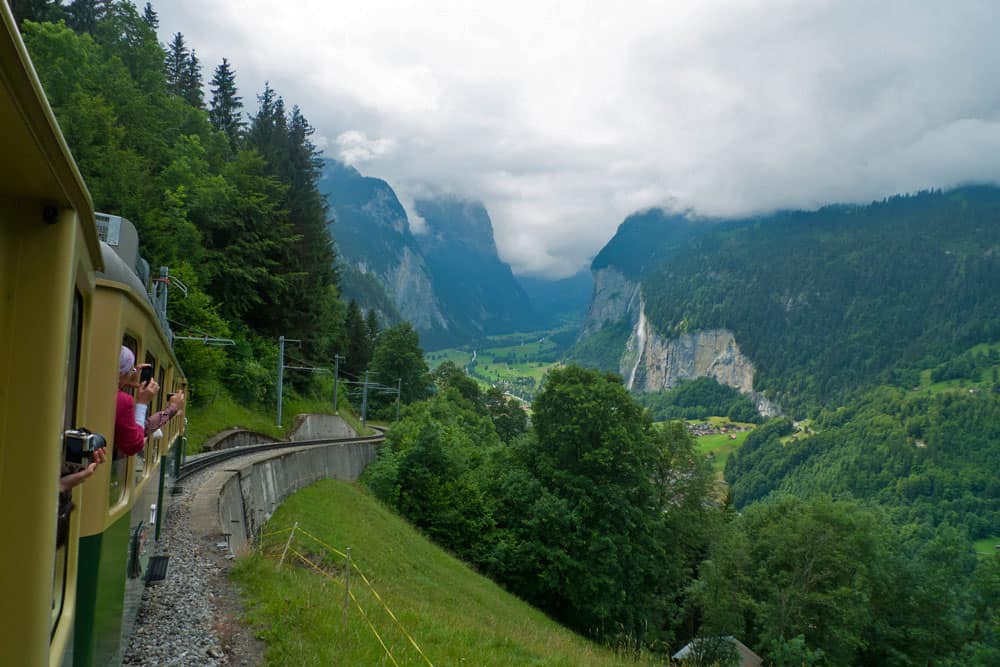
- The Departures Board: You’ll find your train platform via the departure board at the train station. Don’t worry if you don’t see your train because they often only display trains departing within the next 10-20 minutes.
- Self-Service Machines Are In English: Don’t worry if you don’t speak German/French because the ticket machines (and train station signs) are all in English.
- Download The Rail Planner App: There are a number of rail apps but we like the Eurail App — it essentially has the timetables/info for every train in Europe and it doesn’t require an internet connection.
- Pack A Picnic: You’re allowed to bring your own food and alcohol on trains. It’s great for those long train rides.
- Luggage: There aren’t any weight limits on luggage and you can bring as much as you want (well, as much as you can carry). Simply bring it on and store it above your head, behind your seat, or in the luggage racks in each car.
- Making Connections: Your trip might require you to change trains along the journey. Don’t worry if there isn’t much time between trains as switching trains are usually fairly quick and easy (it’s not like flying).
- Get To The Train Station Early: Train stations are usually fairly easy to navigate but they can be a little confusing.
- Know Train Station Names: Most large cities have multiple train stations so this often creates confusion. Double check to make sure you have the right station — especially when booking your ticket. Also, it’s common for there to be stops in the suburbs outside big cities but you won’t want to get off there (just watch what most of the train is doing).
MORE ARTICLES ABOUT Traveling Through Europe
- Step-By-Step To Budget Travel: We break down all the steps to help you plan your budget travel in Europe.
- How To Choose The Best Travel Insurance: Travel insurance will help cover those non-refundable train tickets if something goes wrong during your trip.
- Packing List For Europe Travel: Tips on packing light — which makes train travel much easier.
- European City Price Guides: How much it costs to visit Europe’s most popular cities.
- Best Travel Backpacks: We review our favorite travel backpacks.

No Funny Business
The Savvy Backpacker is reader-supported. That means when you buy products/services through links on the site, I may earn an affiliate commission—it doesn’t cost you anything extra and it helps support the site.
Thanks For Reading! — James
Questions? Learn more about our Strict Advertising Policy and How To Support Us.



